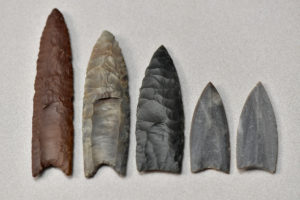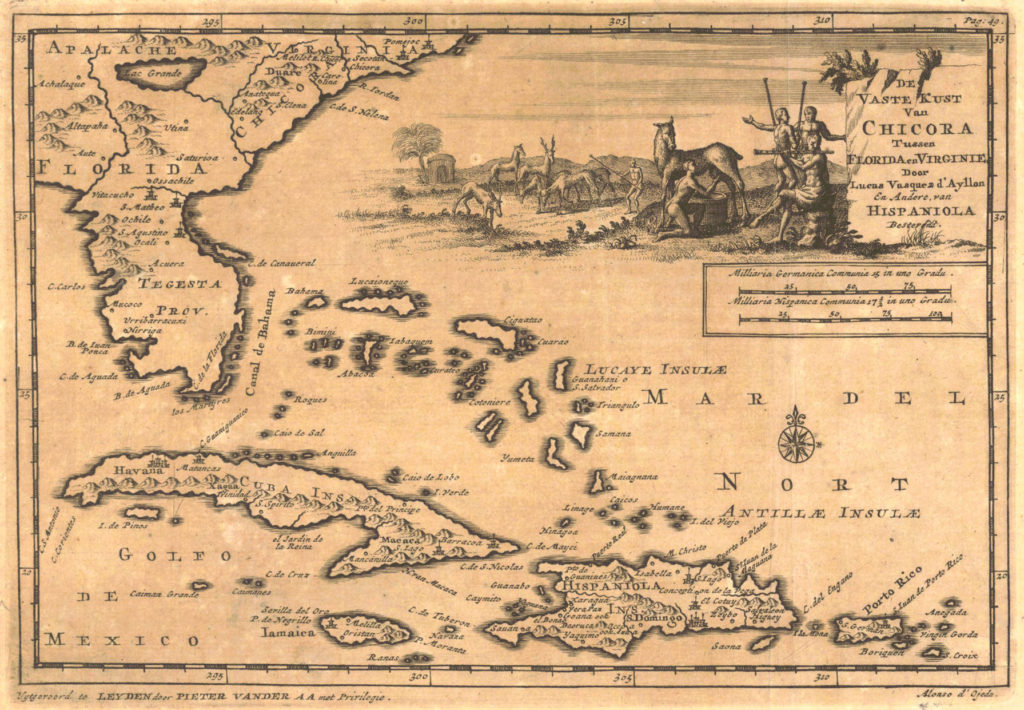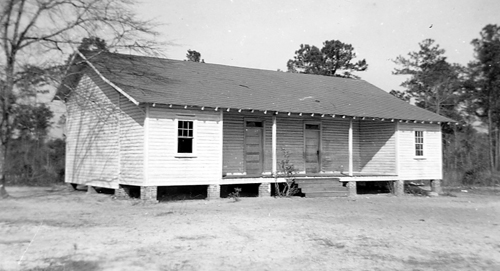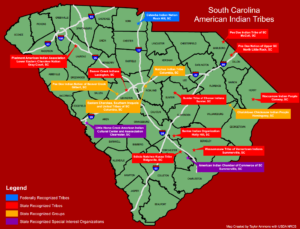A Brief Timeline of Pre-History, History, and the Present of the Waccamaw Indian People
Paleoindian Period (more than 10,000 years ago)

Ancestors of the Waccamaw Indian People during this time were hunter-gatherers living in small groups who took advantage of the rich resources of the Lowcountry. South Carolina archaeological sites like the Topper Site show that they made sophisticated stone spearpoints, called Clovis Points, that were used for hunting large Ice Age mammals like mammoths and mastodons.
Archaic Period (10,000-5,000 years ago)
Waccamaw ancestors used rich coastal environments during the Archaic Period, and archaeological sites that contain extensive shell middens show that clams and oysters were a popular food. They hunted animals like deer and rabbits using spears thrown with an atlatl, and collected plants for food and medicine. Explore more ‘Hunting and Technology’
Woodland Period (5,000-500 years ago)
During this time, the ancestors of the Waccamaw Indian People began to farm important crops like corn, beans, and squash, a trio known as the Three Sisters. They also grew tobacco and continued to hunt animals like deer and rabbits, using a bow and arrow for more accuracy. They made elaborately decorated pottery and other useful things like baskets, nets, and decorated gourds, but these organic items aren’t usually found in the archaeological record because they naturally decompose. Explore The Three Sisters and Tobacco and Pipe to learn more about Native American cultivation.
Arrival of Europeans (1521)

The first European explorers to meet the Waccamaw Indian People were likely Francisco Gordillo and Pedro de Quexos, slavers who came ashore near the mouth of the Santee River in Waccamaw lands in 1521. They captured several people, including a young boy they named Francisco de Chicora, who may be the first Waccamaw person mentioned in written records.
Colonization (1700s)
By the 1700s, the Waccamaw Indian People were profoundly affected by European colonization of their lands. Many people were captured and enslaved, while others suffered from starvation when their farmlands and hunting grounds were taken away by the new arrivals, and even more people died from the introduction of diseases like smallpox. The Waccamaw are mentioned in historic records multiple times during the 1700s, including as the reason for the establishment of a trading post in 1716 by William Waties at Uaunee, or the “Great Bluff” on the Pee Dee River. In 1717, records show that 1,087 deerskins were shipped to Charles Town from the trading post.
Dimery Settlement (1813-modern day)

In 1813, records show that John Dimery and his wife Elizabeth purchased 300 acres of land in the Dog Bluff area of Horry County. They were soon joined by the families of Willis Thompkins, Cockran Thompkins, and Sara Cook. Not long after that, the Turner, Cooper, Hatcher, and Elvis families joined the community, which grew to include two churches and a school. Members of the Waccamaw Indian People today trace their ancestry to these founding families. Explore more here ‘The Dimery Settlement’
Waccamaw Tribal Grounds (2004)
In 2004, the Waccamaw Indian People acquired 20 acres of land in the Dog Bluff area of Aynor, South Carolina, not far from the traditional Dimery Settlement. This land is now used for the Waccamaw Tribal Office, for the annual pauwau, and for other events and activities.

State Recognition (2005)
In 2005, the Waccamaw Indian People became one of two tribes recognized by the state of South Carolina as an Indian tribe pursuant to South Carolina Code of Laws Section 1-31-40(A)(10) and South Carolina Code of Regulations Chapter 139. Today, South Carolina has one Federally recognized tribe, the Catawba, and nine state recognized tribes, including the Waccamaw Indian People.
HR1942 (March 2021)
Earlier this year, Tom Rice, U.S. Representative for South Carolina’s 7th Congressional District, introduced to the 117th Congress the bill H.R.1942 to extend Federal Recognition to the Waccamaw Indian People. Federal Recognition would permit the Waccamaw Indian People to engage in a government-to-government relationship with the United States, to request the return of their ancestors and their belongings from federally-funded museums under the Native American Graves Protection and Repatriation Act (NAGPRA), and grant additional rights and privileges held by federally recognized Native American tribes to the Waccamaw Indian People. Explore more in ‘FUTURE’